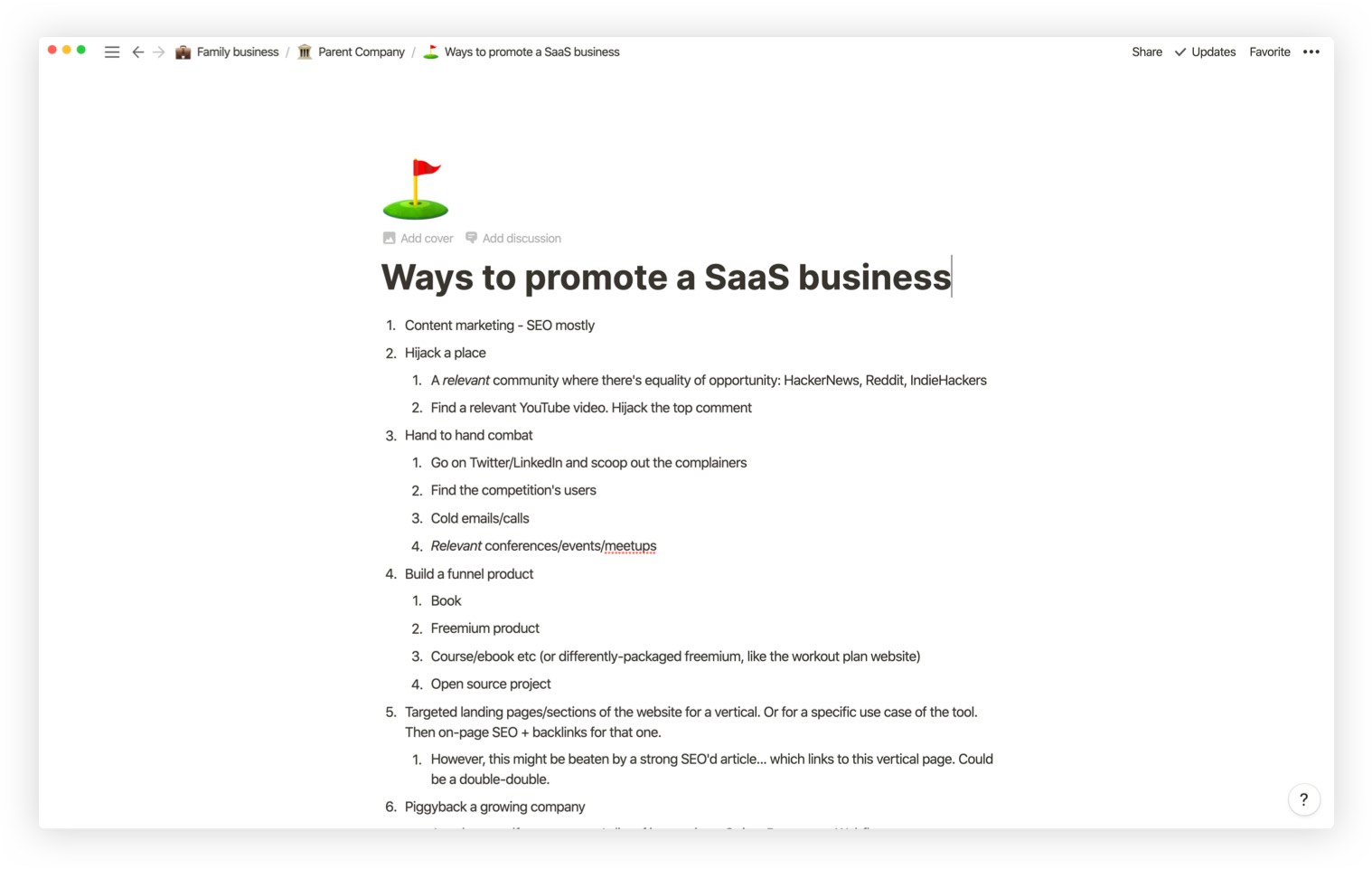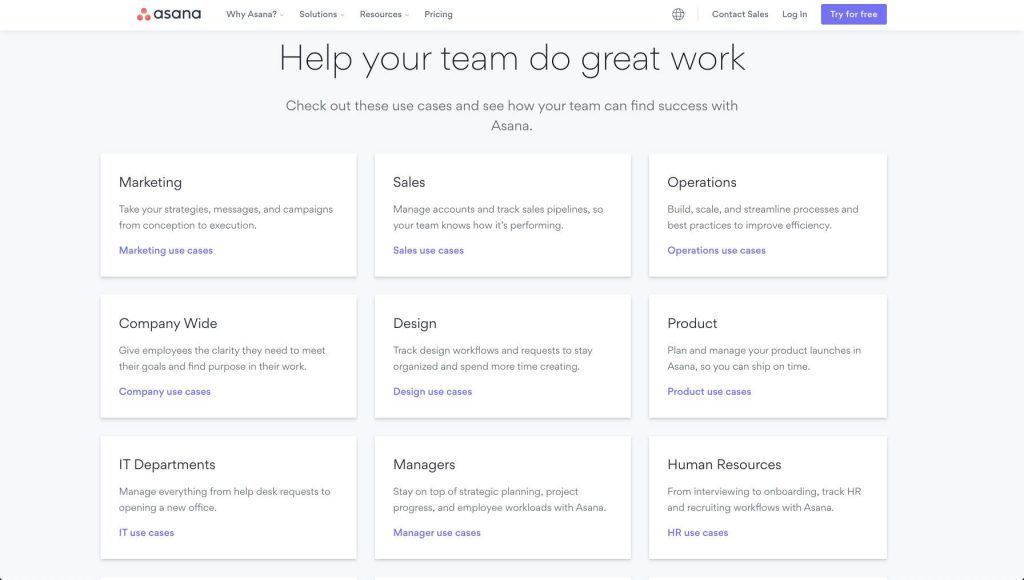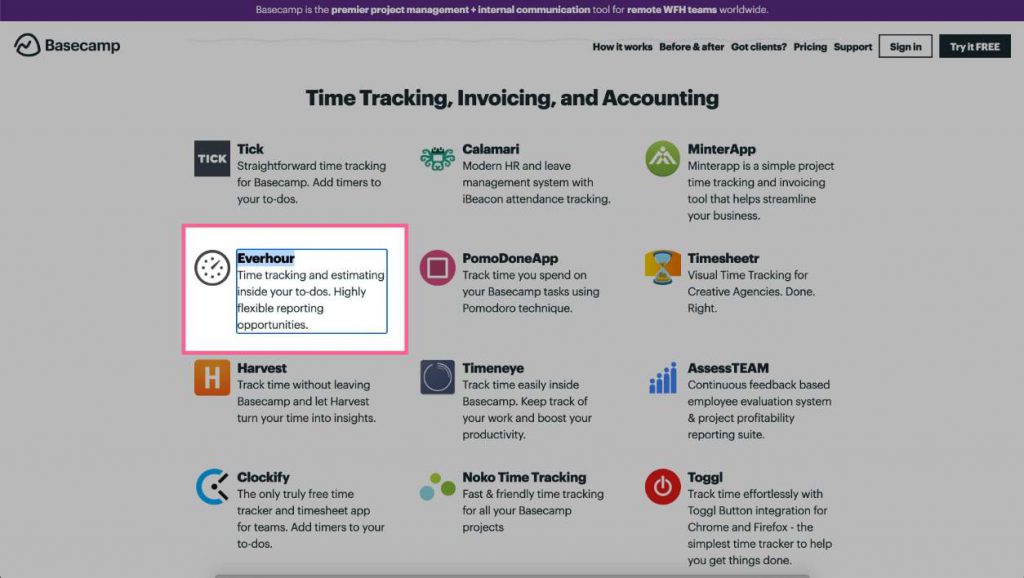
Hey,
So here’s the deal: whether you’re starting out your SaaS business or you’re already running it, you’ve got some ways to reach new people that are at the top of your mind.
But these things come and go: today SEO might be on your mind, tomorrow it might be paid ads.
They come and go for me, so I wanted to make public the internal list that I hold in my Notion account.
I’ve written this across time as I’ve read different articles/books or watched different videos from founders. I think it’s highly relevant for someone who’s just starting out, especially as they can see the big picture: short-term vs long-term options.
This is currently the list — below this list I’ll expand.
You knew this was coming and there are so so many resources online that I don’t want to compete with them on how to do content marketing for your SaaS business.
I wanted to start with it to drop my 2 cents on it: it may not be wise to start with it in the beginning, as you might be validating your product (especially if you’re doing it in a smart way by pre-selling your SaaS tool! Check out my guide on how to do that), but sooner or later this is the long game you should be playing.
When you get there though, focus on what’s considered perennial (or evergreen, as they call it) content.
What you write today will bring more and more users as months go by — and once the piece of content is established, it can keep on bringing paying users for years after you’ve written it.
By hijack I mean engineer your way into a place.
By engineer what I mean is that you want to do it in a smart way: don’t just slap your link in a comment somewhere — help the people in that community help you.
I don’t mean to have you do any black-hat shit like buying likes when I saw “hijack”. But make it so that people have a natural inclination to help you.
In order to do that, you will want to find a community where what you give/sell is relevant. Don’t post in /r/SaaS (and believe me, as a mod, I read everything that’s posted there) if you’re not helping or not even selling to SaaS people.
But that’s basic advice you can find elsewhere. Here’s the valuable bit I can add:
Make sure the communities you choose have equality of opportunity, meaning: everyone can make it to the top.
Reddit and Hacker News have equality of opportunity — if something is really good and targeted at that audience, it will make it to the top.
I got to HackerNews’ top 10 twice in a row, within 48 hours. That’s how I found out about HN:
But here’s the deal: you can make it to the top on HackerNews. And even on some subreddits. But some subreddits have mods that censor any kind of link!
Or perhaps some communities are not made so that your post can be at the top if it’s good.
Think about the old-style forums (like vBulletin) — they’re sorted by the latest comment. If your post is really relevant, it won’t be at the top unless it’s causing debate.
Or maybe even Instagram is a good example of a no-go place — you won’t make it to the explore page unless you’ve built an audience in the past. With Facebook groups it’s the same story: there’s not that much equality of opportunity with a Facebook post, since you’re competing with sensational or polarising content.
A YouTube comment section is not really a place with equality of outcome since non-liked comments don’t really appear by default. Ask for a few friends’ help to get your comment up, so you can get a bit of a boost.
But most importantly, find the relevant video and make sure your SaaS is relevant for the audience of that video.
Leave a comment that helps people and ties in to your SaaS company.
You have to pick your videos carefully — it’s sort of like picking an investment. If you’re right and the video you’re betting on turns out to become popular across time, your comment will ride that wave. Popular, by the way, doesn’t mean millions of views… you can easily ride a niche video with 10k views and get the attention you want for your SaaS.
Or don’t pick your investments. Just play the numbers game. But please don’t spam and do it thoughtfully.
Hand to hand combat is whatever cannot be scaled. Anything you have to do manually.
In the previous place I used to blog, I explained what the complainers are in this piece, which is arrogantly called “Voice of Customers Programs Are For Losers”
This way is highly recommended if you’re still validating your product, or even validating your idea, before your product gets built.
Not much to say here — scoop them up. They’ll do the same to you if you make it big, so don’t stress about that.
It’s the basic rule of capitalism, and capitalism is the game you’re playing: if you’re providing more value, you deserve to be compensated. So make sure you do provide more value.
I’m not a big fan of these, so I don’t have much to say here as I don’t know them myself. But it’s the age-old way!
While it’s still cold reaching out, this happens in-person, so I wanted to delimitate it from the online cold reaching out.
Once again, notice the “relevant” highlight — don’t go to the wrong water hole. Pick it wisely.
A funnel product is, in short, a side product that is built to attract users to the main product.
Think:
The funnel might be free and it’s usually meant to strike a balance between lightweight (in terms of functions, development time and/or cost) and usefulness.
It’s also meant to be highly targeted at a niche — maybe a sub-niche of the niche you’re targeting with your main product.
I wrote this other piece with which I have to check if I still agree. However, the main idea is something I still agree with: as time goes by and more and more products are out there, a funnel product may be the future of freemium.
I give some more examples there of some products that are (or could have been) funnels and are freemium.
Here are some other examples of funnel products you could build for your SaaS product.
Naturally this is a long-term play but books still are a way through which you build credibility, as the word ‘book’ has a millennia-old weight to it.
I should say again: the books has to be relevant to your audience.
Once again: target your audience wisely. You can write a book for yourself, because it’s on a topic you like to explore, but that doesn’t guarantee new users for your SaaS.
Or you can write it for your users, with a targeted topic, and that will be a funnel piece.
Both options are fine, but a relevant book for your audience is the one that can be paired to your SaaS business.
Explained earlier.
Same as the book.
This is highly relevant if you’re targeting techies. Many SaaS tools target techies, but if you’re targeting dentists… well they don’t hang around open-source projects forums.
Here’s what you’ll see if you go on Asana’s website:

They’re not the only ones who do that, but they’re a good example.
Pages explaining their tool was created for a plethora of different verticals that use them. Asana for a HR team is different than Asana for a team of designers.
So what did they do? They cherrypicked use cases and examples and did that for every different audience.
What you can do is pair this with some hand-to-hand combat — reach out some designers/HR teams accordingly with the pitch tailored towards them.
Perhaps you’ll learn even more about where to pivot, if you ever need to do that.
Or perhaps you’ll learn that your tool is showing virality loops between HR teams but it’s not that great for design teams. In fancy-terms I don’t use, you’ll learn that your product/market fit varies, now that you’re trying on different markets.
Worth noting is that my limited SEO experience tells me that, while it’s good to aim for getting this presentation page to #1 in Google (e.g: “Project management tools for design teams”) with on-page SEO, chances are high that the term is highly competitive for just on-page SEO.
In fact, if you search for “Project management tools for design teams”, indeed Asana’s vertical page is there — on number 3 in the search results. Results 0, 1 and 2 are articles.
A well-made article that links to this vertical’s page should add another layer of armour or defensability to this move you’re making.
In other words, you’re making it harder for someone to de-throne you off your #1 position, once you get there.
P.S: I might use this piece of advice with this very article: I might copy the content of the next item from this list (which I think is highly underrated), put it into a new article, and expand on it. It’s the same action, but applied to content marketing.
Pick a growing company and attach yours to them. I’ll explain how. But first, let’s talk about picking.
Remember what I said earlier about the YouTube videos and looking at them as if you’re picking investments?
You can look at life that way, but that’s for another post of mine (which I do plan on writing). You should look at it that way here as well:
Pick a company that you think is growing in the next years, so that if you’re getting it right with this move I’m putting down below, you’ll grow on their back.
Meaning: don’t pick an email company, since there’s so much competition on the market, the email sector has been around for quite a while and it’s had many innovations across time.
It’s not a wave you can catch early.
Don’t pick Stripe, since its period of being an early, undervalued pick is kind of gone. The wave already has some build-up.
Pick something like Webflow, which is hot in the no-code space, if you place your bets on the no-code area.
Pick Figma and attach yourself to them, if you think they’re going to win the design tool wars.
Think of WPEngine — they rode the wave that WordPress has created across years.
What do you do once you pick the company/companies?
See if they have an opening to form a relationship: Everhour is a tool I’ve never used personally, but how they got to $1M/year ARR is a pretty simple and inspiring lesson for me.
They made “budgeting, client invoicing and painless payroll” tool (competitive place, by the way) but made sure they integrated flawlessly with different hot horses:
Everhour’s growth is mainly based on the fact that, once they were mentioned by the “cool kids” (Basecamp, Jira, Asana etc), they automatically got part of those kids’ coolness and authenticity.
Here’s what you’ll see if you go on Basecamp’s “integrations” page:

So let’s take a step back and have a recap:
What should you do, however, if your tool is not made for integrations? Piggyback in some other ways: build a bridge between your tool and bigger company’s. Build an import/export function. Add a feature that connects the two tools.
Tie yourself to them somehow — you might not get on their very website, but at the minimum, users from their forum/communities will link each other if your product is tied to them and it’s valuable.
Piggyback a growing company.
I don’t know much here and neither should you choose these in the early days when you’re looking to validate your product/idea. Just naming some options, but the CH Group Blog is not really your place if you’re looking for info on these:
I’m Ch Daniel and I founded the CH Group. I’m currently building a tool that helps SaaS founders find the best pricing for their product — it’s called PriceUnlock and it’s being built in public!
Besides, I’m running full-time Legit Check By Ch, a company that helped ~6M+ people and that’s got tens of thousands of customers.
See everything I do here, or, if you want to hear more from the CH Group, subscribe in the footer. Thx for reading this!

